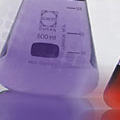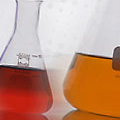|
USGS: Statistics and Information: Thallium
Description
Thallium
Statistics and Information | Thallium, a soft, bluish-gray, malleable heavy metal, was discovered by Sir William Crookes in 1861 while he was making spectroscopic determinations for tellurium on residues from a sulfuric acid plant. Although the metal is reasonably abundant in the Earth's crust at a concentration estimated to be about 0.7 part per million, it exists mostly in association with potassium minerals in clays, soils, and granites and, thus, is not generally considered to be commercially recoverable from those forms. The major source of commercial thallium is the trace amounts found in copper, lead, zinc, and other sulfide ores. Several thallium minerals, containing 16% to 60% thallium, occur in nature as sulfide or selenide complexes with antimony, arsenic, copper, lead, and silver but are rare and have no commercial importance as sources of this element. Thallium also is recovered as a byproduct from the flue dust and residues generated during the roasting and smelting steps in the processing of these ores. Thallium metal and its compounds are consumed in a wide variety of applications; for example, thallium is used in semiconductor material for selenium rectifiers, in gamma radiation detection equipment, in infrared radiation detection and transmission equipment, in crystalline filters for light diffraction for acousto-optical measuring devices, in a mercury-thallium alloy for low-temperature measurements, in glass to increase its refractive index and density, in the synthesis of organic compounds, and in a high-density liquid for sink-float separation of minerals. In addition, research activity with thallium is ongoing to develop high-temperature superconducting materials for such applications as magnetic resonance imaging, storage of magnetic energy, magnetic propulsion, and electric power generation and transmission. Also, the use of radioactive thallium compounds for medical purposes in cardiovascular imaging to detect heart disease is increasing. |
|






